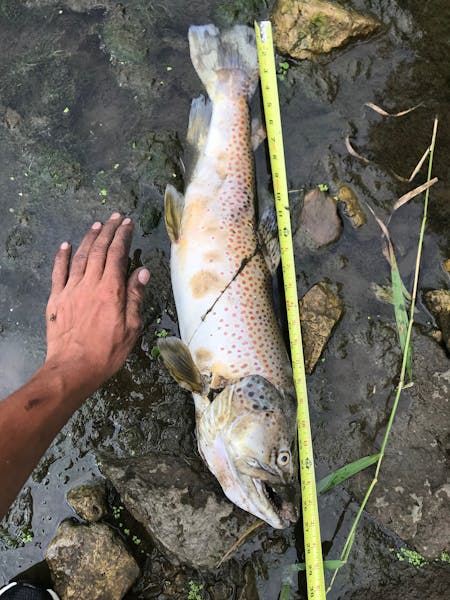Manure and pesticide runoff was likely to blame for a substantial fish kill last summer in a southern Minnesota stream, but its origin could not be pinpointed, a seven-month state investigation has found.
"The was no individual source or single cause," said Justin Watkins, the southeast watershed unit supervisor for the Minnesota Pollution Control Agency (MPCA).
"We did an intense investigation and could not find evidence of a direct discharge of pollutants from a single field, but there was enough evidence to confirm there was runoff and that it contributed."
A trout fisherman found about 2,500 dead fish — mostly brown trout — near Lewiston in Winona County on July 25. It was the area's fourth major fish kill since 2015, with hundreds of fish also suddenly dying in the South Branch of the Whitewater River, Garvin Brook and Trout Valley Creek.
The regularity of the die-offs has outraged neighbors, water quality advocates and anglers concerned about the area's prized trout streams. No single culprit was found for causing the other three fish kills, though they were also linked to manure and pesticide runoff.
"Obviously, we can all see a pattern even if we can't point out the particular parcel that caused it," said John Lenczewski, executive director of Minnesota Trout Unlimited. "It's a perennial problem.
"We need to take a look at our feedlot rules and setback requirements, our manure application rules and pesticide application rules. We need to examine why this keeps happening."
Pollution control officials said they believe the state must take a more proactive approach — to promote ways to reduce the likelihood of fish kills.
The kills in the Lewiston and Rush Creek area had common factors, Watkins said.
All four streams were running low at the time, making them particularly vulnerable to pollutants, he said. Short intense storms followed in each case. The storms were strong enough to carry manure and pesticides from fields into the streams, but they didn't last long enough with the amount of rain needed to actually dilute the chemicals in the runoff.
"What we can do is pay attention to that risk condition — when streams are at a very low flow — and plan accordingly," Watkins said.
The state Department of Agriculture has developed a runoff risk forecast that predicts the likelihood of a strong rainfall on a field-by-field basis throughout Minnesota.
"Everything that is put on the land needs to be put at the right rate, in the right place at the right time," Watkins said. "We have the tools now to help people find the right windows, so they're not applying things when there's going to be a storm in the next couple days."
In the spring, the MPCA will start a new informational campaign to help manage the risk of runoff-caused fish kills. That campaign could include newsletters, training sessions, fact sheets and presentations.
"We need to be communicating about the risk and what tools are useful," Watkins said.
Jeff Broberg, a geologist and founder of the Minnesota Well Owners Organization, said the frequency of the fish kills is evidence that the state must increase its oversight over feedlots. He said authorities should make sure the operations are regularly inspected, applying and storing manure properly and keeping accurate records as required by law.
"These fish kills are unacceptable and they are preventable," Broberg said. "We can't normalize this level of pollution."
The MPCA investigation found that two feedlots near Rush Creek did not keep proper records of where and when they spread manure. In addition, owners of a dairy farm in Lewiston violated setback rules by spreading manure too close to a sinkhole and a special protection area, investigators found.

Shop the curbs for free on 'Trash to Treasure Day' in White Bear Lake

Longtime Uptown boutique closing in May

Meet the Athena Award winners: 103 female athletes honored by their schools

Lacrosse lists: 21 top players and the school that's No. 1 for boys and girls

